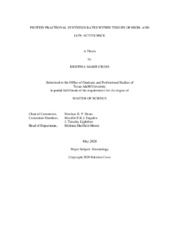| dc.description.abstract | With the rise in physical inactivity and its related diseases, it is necessary to understand the mechanisms involved in physical activity regulation. Scientists have explored physical activity regulation by investigating various physiological mechanisms involving hormones, neurotransmitters, and genetics; however, little is known about the role of metabolism on physical activity level. We hypothesize that protein turnover in specific organs is higher in mice previously exhibiting high physical activity levels, as a mechanism to adapt to the increased demand. Therefore, we studied protein fractional synthesis rate (FSR) in tissues of inherently high and low active mice. In order to study protein FSR of various organs, we assessed 12-week-old male inherently low-active (LA) mice (n=14, lean body mass: 21.0±1.1g, C3H/HeJ strain) and high active (HA) mice (n=14, lean body mass: 22.5±1.3, C57L/J strain). One day before tissue collection, a D2O bolus was administered via intraperitoneal injection, and mice were provided D2O enriched drinking water to enrich the total body water to about 5% D2O. Blood samples and eleven tissues (kidney, heart, lung, muscle, fat, jejunum, ileum, liver, brain, skin, and bone) were collected and analyzed for enrichment of alanine in the plasma and protein-bound pool (LC-MS/MS). FSR was calculated as -ln(1-enrichment) as fraction per day. Data are mean±SE (unpaired t-test: GraphPad Prism 8.3.1).
The kidney protein FSR in the low-active mice were 7.82% higher than the high active mice (low-active 0.1863±0.0018, high-active 0.1754±0.0028, p= 0.0030). No significant differences were found between protein FSR of high-active and low-active mice in any of the other measured organ. Although the kidney tissue resulted in significant differences, we do not deem the findings as physiologically different because a protein synthesis difference of only 7.82% is not physiologically relevant. The observed lack of significant differences in high and low-active mice suggests that differences in specific organ tissue protein turnover may not be a mechanism regulating inherent physical activity level. Since protein turnover is representative of the ability to adapt through upregulation and downregulation of metabolic processes, these results show that high-active mice are inherently no more equipped for metabolic regulation than the low active mice. | en |


